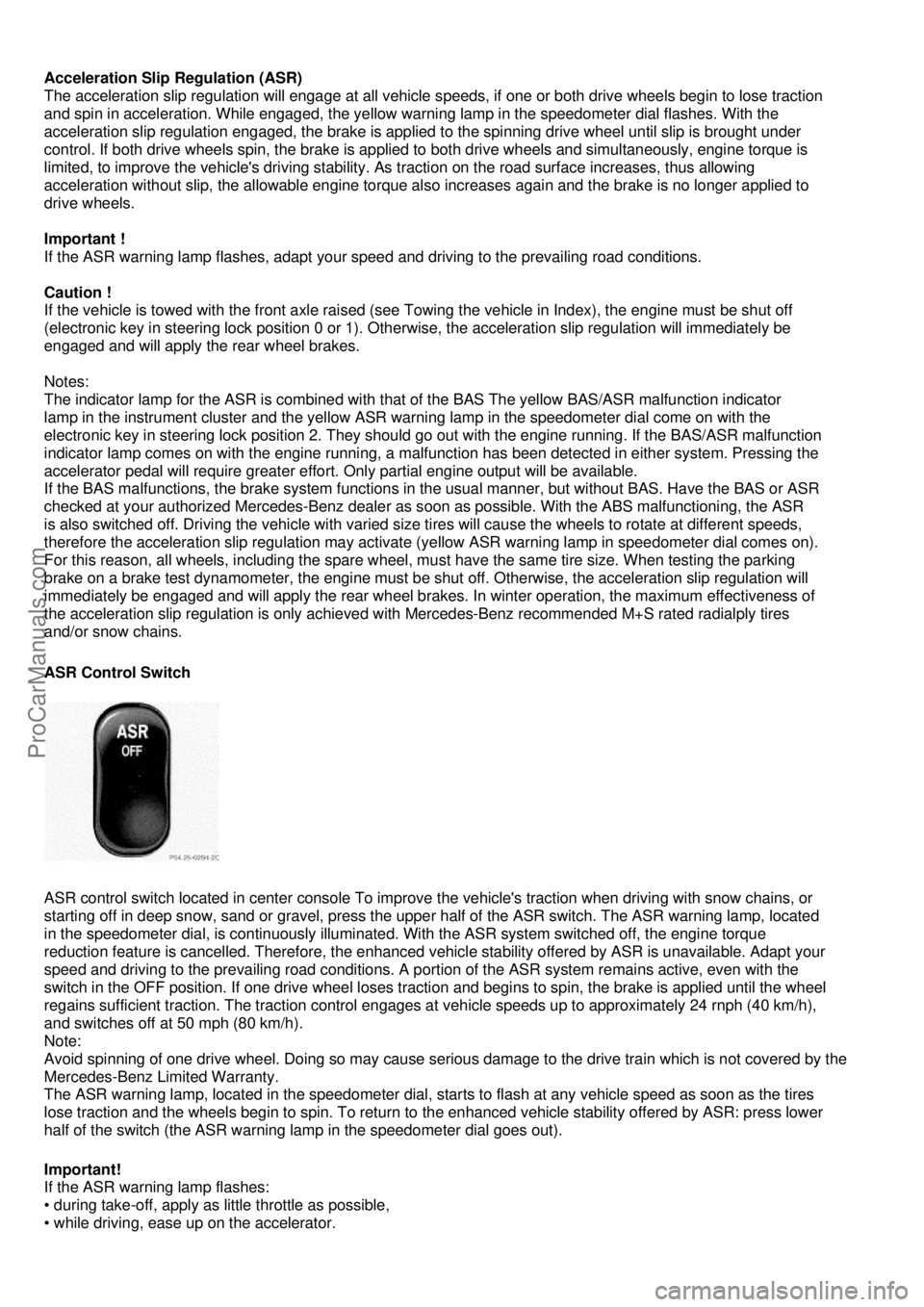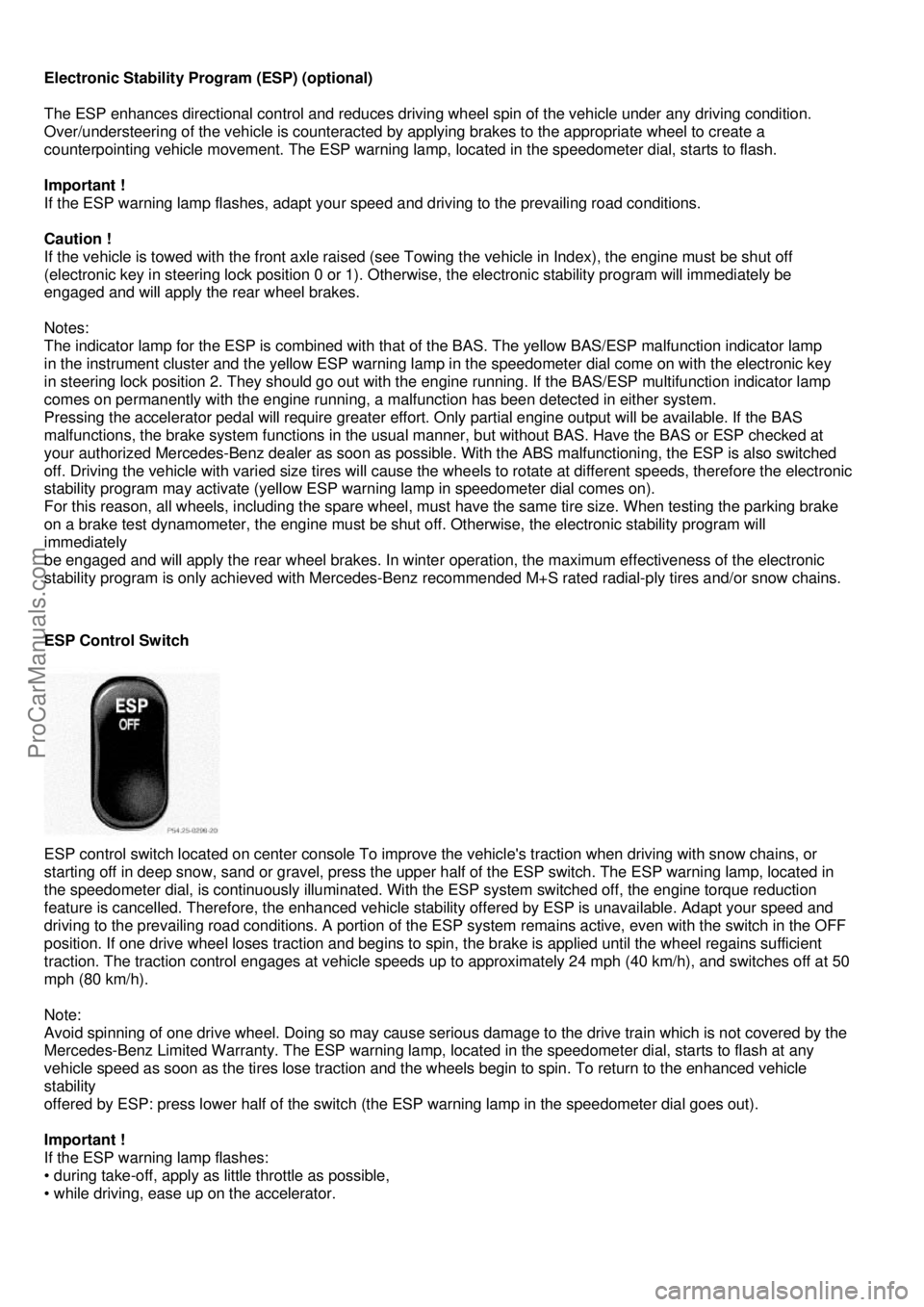1999 MERCEDES-BENZ C-280 steering
[x] Cancel search: steeringPage 72 of 122

Flexible Service System (FSS)
The FSS permits a flexible service schedule that is dire
ctly related to the operating conditions of the vehicle.
The symbol
or appears in the main odometer field prior to the next suggested service. Depending on operating
conditions throughout the year, the nex t service is calculated and displayed in days or distance remaining. The
message is displayed for approx. 10 seconds when turning the electronic key in steering lock to position 2, or it can
be canceled manually by pressing button 0. Once the suggested term has passed, the message plus symbol
or
, preceded by a - (minus symbol) blinks, when turning t he electronic key to position 2. The FSS display can also
be called up for approx.10 seconds with display illuminated by pressing button 0 twice. Following a completed service
the Mercedes-Benz dealer sets the counter to 10 000 miles (Canada: 15 000 km) and 365 days.
The counter can also be set by any individual. To do so:
1 . Turn electronic key in steering lock to position 2.
2 . Within 4 seconds press button 0 twice.
3 . The present status for days or distance is displayed. Within 10 seconds turn electronic key in steering lock to
position 0.
4 . Press and hold button 0, while turning electronic key in steering lock to position 2 again. The present status for
days or distance is displayed once more. Continue to hold button 0 After approx. 10 seconds a signal sounds, and the
display shows 10 000 miles (Canada: 15000 km).
5 . Release button 0. If the FSS counter was inadvertently reset, have a Mercedes -Benz dealer correct it.
Notes:
When disconnecting vehicle battery for one or more days at a time, such days will not be counted. Any such days not
counted by the FSS can be added by your Mercedes-Benz de aler. The interval between services is determined by
the kind of vehicle operation. Driving at extreme speeds, and cold starts combined with short distance driving in which
the engine does not reach normal operating temperat ure, reduce the interval between services.
Model C 230:
The FSS allows for distances between 10 000 miles (Canada: 15 000 km) and 15 000 miles (Canada: 22 500 km),
or from 365 to 730 days between services.
Models C 280 and C 43 AMG:
The FSS allows for distances between 10 000 miles (Canada: 15 000 km) and 20 000 miles (Canada: 30 000 km),
or from 365 to 730 days between services. However you choose to set your reference numbers, the scheduled
services as posted in the Service Booklet must be followed to properly care for your vehicle.
ProCarManuals.com
Page 73 of 122

Antilock Brake System (ABS)
Important !
The ABS improves steering control of the vehicle during braking maneuvers. Do not pump the brake pedal, rather use
firm, steady brake pedal pressure. Pu mping the brake pedal defeats the pur pose for ABS and significantly reduces
braking effectiveness.
The ABS prevents the wheels from locking up above a vehicl e speed of approximately 5 mph (8 km/h) independent of
road surface conditions.
At the instant one of the wheels is about to lock up, a slight pulsation can be felt in the brake pedal, indicating that the
ABS is in the regulating mode. Keep firm and steady pressure on the brake pedal while experiencing the pulsation.
On slippery road surfaces, the ABS will re spond even with light brake pedal pressure because of the increased
likelihood of locking wheels. The pulsating brake pedal can be an indication of hazardous road conditions and
functions as a reminder to take extra care while driving.
ABS Control
The ABS malfunction indicator lamp in the instrument cl uster comes on with the electronic key in steering lock
position 2 and should go out when the engine is running.
If the charging voltage falls below 10 volts, the malfunction indicator lamp comes on and the ABS is switched off.
When the voltage is above this value again, the malfunction indicator lamp should go out and the ABS is operational.
With the ABS malfunctioning, the ASR or ESP, if vehicl e so equipped, are also switched off. Both malfunction
indicator lamps come on with the engine running. If the ABS malfunction indicator lamp does not go out or comes on
while driving, it indicates that the ABS has detected a malfunction and has switched off. In this case, the brake
system functions in the usual manner, but without antilock assistance.
Have the system checked at your authorized Mercedes-Benz dealer as soon as possible.
Warning !
ABS cannot prevent the natural laws of physics from acting on the vehicle, nor can it increase the traction
made available by the road conditions. The ABS ca nnot prevent accidents, including those resulting from
excessive speed in turns, following another vehicle too cl osely, or aquaplaning. Only a safe, attentive, and
skillful driver can prevent accidents. The capabilities of an ABS equipped car must never be exploited in a
reckless or dangerous manner which could jeopardize the user's safety or the safety of others.
Note:
To alert following vehicles to slippery road conditions you discover, operate your hazard warning flashers as
appropriate.
ProCarManuals.com
Page 74 of 122

Brake Assist System (BAS)
Warning !
BAS cannot prevent the natural laws of physics from acting on the vehicle, nor can it increase braking
efficiency beyond that afforded by the condition of the vehicle brakes and tires or the traction afforded. The
BAS cannot prevent accidents, including those resulting from excessive speed in turns, following another
vehicle too closely, or aquaplaning. Only a safe, at tentive, and skillful driver can prevent accidents. The
capabilities of a BAS equipped car must never be explo ited in a reckless or dangerous manner which could
jeopardize the user's safety or the safety of others.
The Brake Assist System is designed to maximize the vehicle's braking capability during emergency braking
maneuvers by having maximum power boost applied to the br akes more quickly in emergency braking conditions
than might otherwise be afforded solely by the driver's braking style. This can help reduce braking distances over
what ordinary driving and braking style might do. The BAS complements the Antilock Brake System (ABS).
To receive the benefit of the system you must apply continuous full braking power during the stopping sequence. Do
not reduce brake pedal pressure.
Once the brake pedal is released, the BAS is deactivat ed The indicator lamps for the ASR and ESP are combined
with the BAS indicator lamp.
The BAS/ASR or BAS/ESP malfunction indicator lamp in the instrument cluster corne on with the electronic key in
steering lock position 2 and should go out with the engine running.
If the BAS/ASR or BAS/ESP malfunction indicator lamp co mes on permanently while the engine is running, a
malfunction has been detected in either system. As a result, it is possible that now only partial engine output will be
available, and pressing the accelerator pedal will require more effort. If the BAS malfunctions. The brake system
functions in the usual manner, but wi thout BAS. If the charging voltage falls be low 10 volts, the malfunction indicator
lamp comes on and the BAS is switched off. When the volt age is above this value again, the malfunction indicator
lamp should go out and the BAS is operational. With t he ABS malfunctioning, the BAS, ASR or ESP are also
switched off. Both malfunction indicator lamps come on with the engine running. Have the BAS, ASR or ESP checked
at your authorized Mercedes-Benz dealer as soon as possible .
ProCarManuals.com
Page 75 of 122

Acceleration Slip Regulation (ASR)
The acceleration slip regulation will engage at all vehicle s peeds, if one or both drive wheels begin to lose traction
and spin in acceleration. While engaged, the yellow warni ng lamp in the speedometer dial flashes. With the
acceleration slip regulation engaged, the brake is applied to the spinning drive wheel until slip is brought under
control. If both drive wheels spin, the brake is applied to both drive wheels and simultaneously, engine torque is
limited, to improve the vehicle's driving stability. As traction on the road surface increases, thus allowing
acceleration without slip, the allowable engine torque also increases again and the brake is no longer applied to
drive wheels.
Important !
If the ASR warning lamp flashes, adapt your spee d and driving to the prevailing road conditions.
Caution !
If the vehicle is towed with the front axle raised (see Towing the vehicle in Index), t he engine must be shut off
(electronic key in steer ing lock position 0 or 1). Othe rwise, the acceleration slip regulation will immediately be
engaged and will apply the rear wheel brakes.
Notes:
The indicator lamp for the ASR is combined with that of the BAS The yellow BAS/ASR malfunction indicator
lamp in the instrument cluster and the yellow ASR warning lamp in the speedometer dial come on with the
electronic key in steering lock position 2. They should go out with the engine running. If the BAS/ASR malfunction
indicator lamp comes on with the engine running, a malfunc tion has been detected in either system. Pressing the
accelerator pedal will require greater effort. Only partial engine output will be available.
If the BAS malfunctions, the brake system functions in the usual manner, but without BAS. Have the BAS or ASR
checked at your authorized Mercedes-Benz dealer as soon as possible. With the ABS malfunctioning, the ASR
is also switched off. Driving the vehicle with varied size tires will cause the wheels to ro tate at different speeds,
therefore the acceleration slip regulation may activate (ye llow ASR warning lamp in speedometer dial comes on).
For this reason, all wheels, including the spare wheel, mu st have the same tire size. When testing the parking
brake on a brake test dynamometer, the engine must be shut off. Otherwise, t he acceleration slip regulation will
immediately be engaged and will apply the rear wheel brakes . In winter operation, the maximum effectiveness of
the acceleration slip regulation is only achieved with Mercedes-Benz recommended M+S rated radialply tires
and/or snow chains.
ASR Control Switch
ASR control switch located in center console To improve
the vehicle's traction when driving with snow chains, or
starting off in deep snow, sand or gravel, press the upper half of the ASR switch. The ASR warning lamp, located
in the speedometer dial, is cont inuously illuminated. With the ASR system switched off, the engine torque
reduction feature is cancelled. Therefore, the enhanced vehicle stability offered by ASR is unavailable. Adapt your
speed and driving to the prevailing road conditions. A por tion of the ASR system remains active, even with the
switch in the OFF position. If one drive wheel loses traction a nd begins to spin, the brake is applied until the wheel
regains sufficient traction. The traction control engages at vehicle speeds up to approximately 24 rnph (40 km/h),
and switches off at 50 mph (80 km/h).
Note:
Avoid spinning of one drive wheel. Doing so may cause seriou s damage to the drive train which is not covered by the
Mercedes-Benz Limited Warranty.
The ASR warning lamp, located in the speedometer dial, star ts to flash at any vehicle speed as soon as the tires
lose traction and the wheels begin to spin. To return to the enhanced vehicle stability offered by ASR: press lower
half of the switch (the ASR warning lamp in the speedometer dial goes out).
Important!
If the ASR warning lamp flashes:
• during take-off, apply as little throttle as possible,
• while driving, ease up on the accelerator.
ProCarManuals.com
Page 76 of 122

Electronic Stability Program (ESP) (optional)
The ESP enhances directional control and reduces driving wheel spin of the vehicle under any driving condition.
Over/understeering of the vehicle is counteracted by applying brakes to the appropriate wheel to create a
counterpointing vehicle movement. The ESP warning lamp, located in the speedometer dial, starts to flash.
Important !
If the ESP warning lamp flashes, adapt your speed and driving to the prevailing road conditions.
Caution !
If the vehicle is towed with the front axle raised (see Towing the vehicle in Index), t he engine must be shut off
(electronic key in steer ing lock position 0 or 1). Otherwise, the el ectronic stability program will immediately be
engaged and will apply the rear wheel brakes.
Notes:
The indicator lamp for the ESP is combined with that of the BAS. The yellow BAS/ESP malfunction indicator lamp
in the instrument cluster and the yello w ESP warning lamp in the speedometer di al come on with the electronic key
in steering lock position 2. They should go out with th e engine running. If the BAS/ESP multifunction indicator lamp
comes on permanently with the engine running, a malfunction has been detected in either system.
Pressing the accelerator pedal will require greater effort. Only partial engine output will be available. If the BAS
malfunctions, the brake system functions in the usual manner, but without BAS. Have the BAS or ESP checked at
your authorized Mercedes-Benz dealer as soon as possible. With the ABS malfunctioning, the ESP is also switched
off. Driving the vehicle with varied size ti res will cause the wheels to rotate at different speeds, therefore the electronic
stability program may activate (yellow ESP warning lamp in speedometer dial comes on).
For this reason, all wheels, including the spare wheel, must have the same tire size. When testing the parking brake
on a brake test dynamometer, the engine must be shut off. Otherwise, t he electronic stability program will
immediately
be engaged and will apply the rear wheel brakes. In winter operation, the maximum effectiveness of the electronic
stability program is only achieved with Mercedes-Benz reco mmended M+S rated radial-ply tires and/or snow chains.
ESP Control Switch
ESP control switch located on center co
nsole To improve the vehicle's traction when driving with snow chains, or
starting off in deep snow, sand or gravel, press the upper half of the ESP switch. The ESP warning lamp, located in
the speedometer dial, is continuously illuminated. With the ESP system switched off, the engine torque reduction
feature is cancelled. Therefore, the enhanced vehicle stability offered by ESP is unavailable. Adapt your speed and
driving to the prevailing road conditio ns. A portion of the ESP system remains ac tive, even with the switch in the OFF
position. If one drive wheel loses traction and begins to spin , the brake is applied until the wheel regains sufficient
traction. The traction control engages at vehicle speeds up to approximately 24 mph (40 km/h), and switches off at 50
mph (80 km/h).
Note:
Avoid spinning of one drive wheel. Doing so may cause seriou s damage to the drive train which is not covered by the
Mercedes-Benz Limited Warranty. The ESP warning lamp, located in the speedome ter dial, starts to flash at any
vehicle speed as soon as the tires lose traction and the wheels begin to spin. To return to the enhanced vehicle
stability
offered by ESP: press lower half of the switch (the ESP warning lamp in the speedometer dial goes out).
Important !
If the ESP warning lamp flashes:
• during take-off, apply as little throttle as possible,
• while driving, ease up on the accelerator.
ProCarManuals.com
Page 82 of 122

Odometer Display Field
(Models C 280 and C 43 AMG)
Turn electronic key in steering lock to position 2 and wait until the symbols
and appears in the
odometer display field. Within 1 second press button 0 twice.
The following messages are available:
"OK"
"-1.0 Q" (Canada: -1.0 L)
"-1.5 Q" (Canada: -1.5L)
"-2.0 Q" (Canada: -2.0 L)
Add oil to upper (max) mark of the dipstick."HI"
Do not overfill the engine.
Excessive oil must be drained or siphoned. It could caus e damage to engine and catalytic converter not covered
by the Mercedes-Benz Limi ted Warranty. The symbol
flashes in the odometer field if a proper oil level check
cannot be performed. The oil level check
can be repeated after a short while. Perform the oil level check with the dipstick, if it cannot be completed via the
odometer display field. In this case we recommend that you have the system checked at a Mercedes-Benz dealer.
Automatic Transmission Fluid Level
The transmission has a permanent fill of automatic tran smission fluid. Regular automatic transmission fluid
level checks and changes are not required. For this reason the dipstick is omitted. If you notice fluid leaks or
gear shifting malfunctions, have your authorized Mercede s-Benz dealer check the transmission fluid level.
ProCarManuals.com
Page 95 of 122

Battery
Warning !
Failure to follow these instructions can result in severe injury or death. Never lean over batteries while
connecting, you might get injured. Battery fluid contains sulfuric acid. Do not allow this fluid to come in
contact with eyes, skin or clothing. In case it does, immediately flush affected area with water and seek
medical help if necessary. A battery will also produ ce hydrogen gas, which is flammable and explosive.
Keep flames or sparks away from battery, avoid im proper connection of jumper cables, smoking etc..
Important !
Battery maintenance information:
The battery is located in the trunk under the trunk floor. The fluid level must be checked at every A and B service.
Always insure that the fluid level is at the specified maximum level and that only distilled water is used. Failure to
maintain proper fluid level may result in cell deterioration and possible battery rupture. The service life of the battery is
dependent on its condition of charge. The battery should alwa ys be kept sufficiently charged, in order to last an
optimum length of time.
Therefore, we strongly recommend that you have the battery charge checked frequently, and corrected if
necessary, especially if you use the vehicle less than approximately 200 miles (300 km) per month, mostly for
short distance trips, or if it is not used for long periods of time.
Only charge a battery with a battery charger after the battery has been disconnected from the vehicle electrical circuit.
Always disconnect the battery negative lead first and connect last. When removing and connecting the battery,
always make sure that all electrical consumers are off and the electronic key is in steering lock position 0. The battery
and its vent tube must always be securely installed when the car is in operation. While the engine is running the
battery terminal clamps must not be loosened or detached, otherwise the generator and other electronic components
would be damaged.
Note:
After reconnecting the battery al so resynchronize the Express feature of the power windows
(see Power Windows in Index).
Battery Recycling
Batteries contain materials that can harm the environment with improper disposal. Large 12 Volt storage batteries
contain lead. Recycling of batteries is the preferred method of disposal. Many states require sellers of batteries to
accept old batteries for recycling.
ProCarManuals.com
Page 98 of 122

All except C 43 AMG
C 43 AMG
Towing the Vehicle
The rear towing eye is located at the right, below the bumper.
The front towing eye is located on the passenger side behind a cover in the bumper panel.
Models C 230 and C 280:
Cover removal:
Insert finger in recess on left end of cover and pull cover out.
Cover installation:
Engage cover at top right and press cover in securely
.
Model C 43 AMG:
Cover removal:
Hold left and right end of grille and pull out.
Cover installation:
Engage cover at bottom and press in top securely.
We recommend that the vehicle be transported using flat bed equipment. This method is preferable to other
types of towing. The vehicle may be towed with all wheel s on the ground and the selector lever in position "N"
for distances up to 30 miles (50 km) and at a speed not to exceed 30 mph (50 km/h). The electronic key must
be in steering lock position 2. To positively avoid a possibility of damage to the transmission, however, we
recommend to disconnect the drive shaft at the rear axle drive flange on any towing beyond a short tow to a nearby
garage. Do not tow with sling-type equipment. Towing with sling-type equipment over bumpy roads will damage
radiator and supports. Use wheel lift, dolly, or flat bed equipment, with electronic key in steering lock turned to
position 0.
Warning !
With the engine not running, there is no power assistance for the braking and steering systems, in this case,
it is important to keep in mind that a considerably higher degree of effort is necessary to brake and steer
the vehicle.
Note:
To signal turns while being towed with hazard warning flas her in use, turn electronic key in steering lock to
position 2 and activate combination switch for left or right turn signal in usual manner - only the selected turn
signal will operate. Upon cancelling the turn signal, the hazard warning flasher will operate again.
Caution !
Vehicles with Acceleration Slip Regulation (ASR)
If the vehicle is towed with the front axle raised, the engi ne must be shut off (electronic key in steering lock position
0 or 1). Otherwise, the ASR will immediately be engaged and will apply the rear wheel brakes.
Caution !
Vehicles with Electronic Stability System (ESP)
If the vehicle is towed with the front axle raised, the engine must be shut off (electronic key in steering lock position
0 or 1). Otherwise, the ESP will immediately be engaged and will apply the rear wheel brakes.
ProCarManuals.com